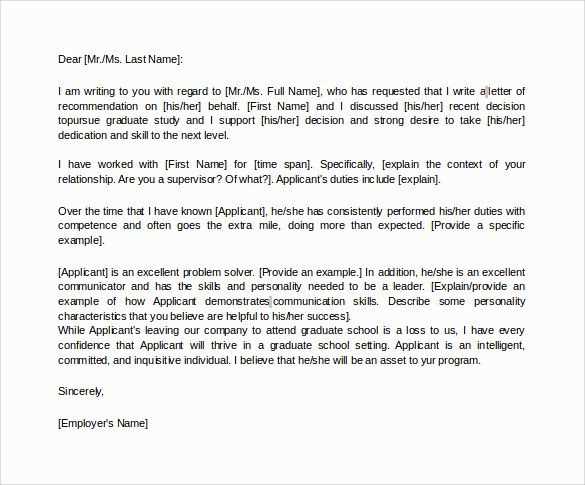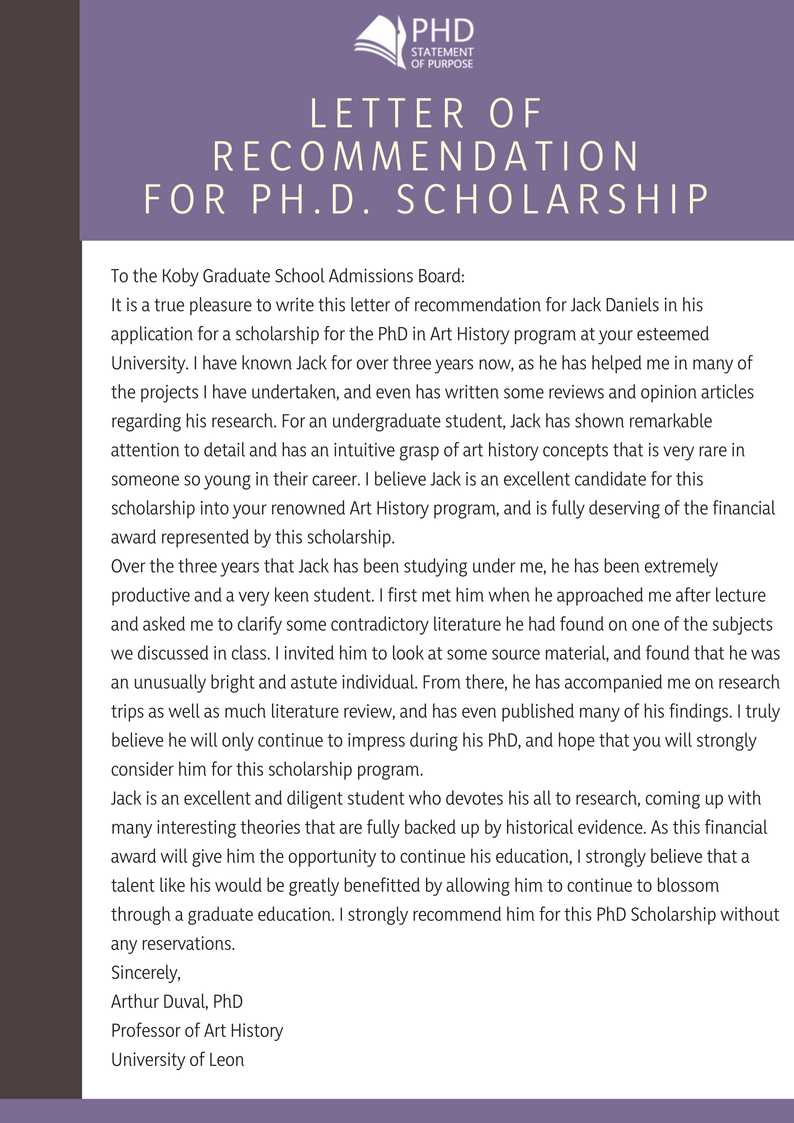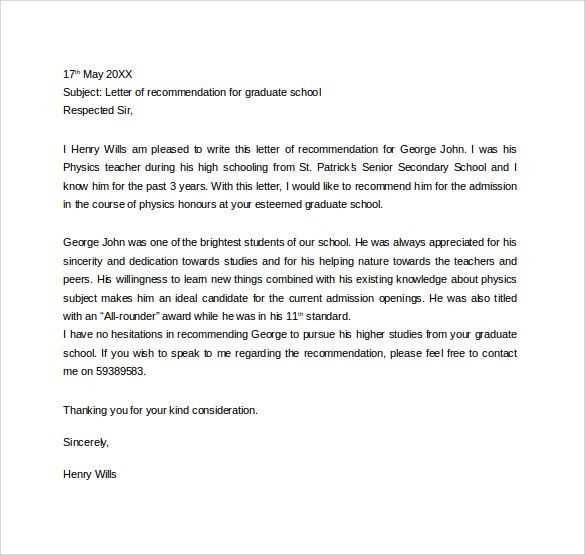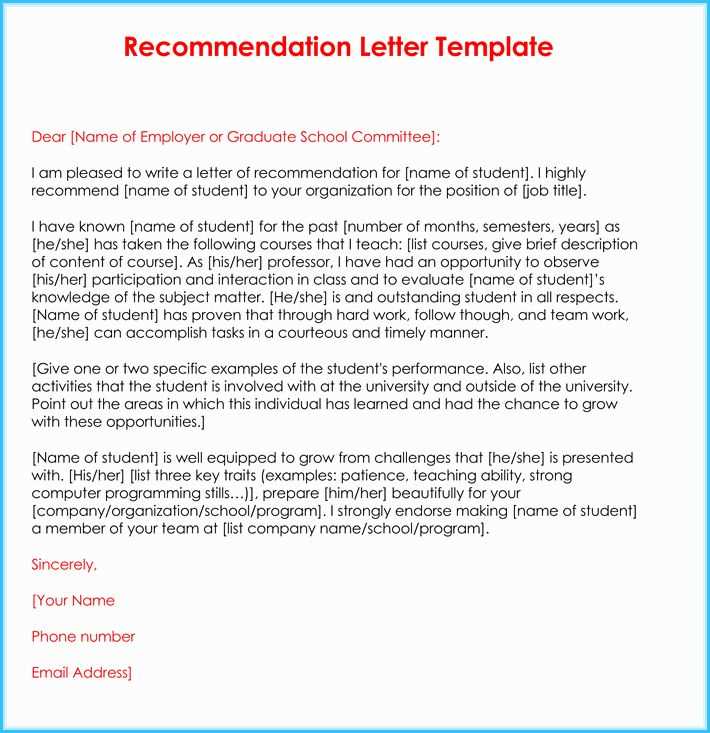Graduate School Recommendation Letter Template

When tasked with supporting a candidate’s application to further their academic career, writing a compelling statement is crucial. The goal is to present the individual’s strengths, potential, and suitability for the desired program. A well-crafted document serves as a reflection of their qualifications and personal attributes, providing a clear picture of why they stand out.
Effective endorsements not only focus on the person’s academic achievements but also emphasize qualities that demonstrate their readiness for advanced challenges. Whether it’s their dedication to learning or ability to contribute meaningfully to a community, such a text should go beyond surface-level praise and offer specific examples.
The key is to balance professionalism with personal insight. Highlighting the candidate’s character alongside their accomplishments helps establish a connection with the admissions committee, making them see the applicant as more than just a list of grades and test scores. A thoughtful, detailed statement can greatly influence the success of an application, making it essential to approach this task with care and consideration.
Key Elements of a Recommendation Letter
To effectively endorse an applicant, certain components must be included to ensure clarity and impact. These elements work together to provide a complete picture of the individual, allowing the reader to assess their potential and suitability for the program. A well-rounded submission emphasizes both achievements and character, presenting the candidate as a strong fit.
Introduction and Context
The opening of the document should establish the context for the endorsement. It’s important to introduce the relationship between the writer and the applicant, explaining how long they have known each other and in what capacity. This provides the reader with insight into the level of authority the writer holds in assessing the applicant’s qualifications.
Specific Examples and Achievements

Rather than making vague statements, the endorsement should include concrete examples that highlight the candidate’s strengths. These could be related to academic performance, problem-solving skills, leadership, or other relevant traits. Specific instances of how the individual excelled in particular situations help support the claims made about their abilities.
Structuring the Perfect Graduate School Reference

Creating a well-organized and impactful endorsement requires a clear structure to ensure all important details are conveyed effectively. Each part should build upon the other, guiding the reader through the strengths and achievements of the individual in a coherent and logical manner. A strong structure makes the content more persuasive and memorable.
The first step is to begin with a strong introduction that briefly establishes the relationship between the writer and the candidate, offering context for the evaluation. This sets the stage for the subsequent discussion of the applicant’s qualifications and personal traits. Building a strong opening helps establish credibility and trust with the reader from the start.
Following the introduction, the body of the endorsement should focus on key achievements and characteristics that directly relate to the applicant’s readiness for the program. Providing specific examples of the individual’s skills, contributions, and successes strengthens the case. The conclusion should then reinforce the applicant’s qualifications while making a compelling final statement about their potential to succeed.
How to Highlight Academic Achievements
Focusing on the candidate’s academic accomplishments is essential to demonstrating their ability to succeed in advanced studies. Specific details about performance, dedication, and expertise in relevant subjects should be emphasized. Highlighting achievements not only strengthens the candidate’s profile but also provides concrete evidence of their potential.
Presenting Key Academic Successes
When showcasing the applicant’s academic achievements, it’s important to mention notable successes that directly support their qualifications. This could include high grades, challenging coursework, or standout projects. To effectively highlight these, consider including:
- Top grades in relevant subjects or courses
- Special projects or research that demonstrate initiative and creativity
- Awards, honors, or scholarships received during studies
Demonstrating Depth of Knowledge
Beyond basic academic performance, it’s essential to show how the candidate’s expertise sets them apart. This can be done by emphasizing the depth of their knowledge in specific areas or their ability to tackle complex concepts. Focus on:
- The candidate’s involvement in specialized courses or workshops
- Research contributions or academic papers published
- Contributions to group discussions or academic collaborations
Crafting a Personal Connection in Your Letter
Building a personal connection with the reader is a critical element in any supportive statement. A more humanized approach helps the admissions committee see the applicant not just as a list of accomplishments but as a well-rounded individual. By weaving in personal observations and meaningful anecdotes, you create a narrative that makes the candidate more memorable.
Sharing Meaningful Interactions
Relating specific experiences where you worked closely with the candidate provides a window into their personality and work ethic. These moments of interaction highlight the individual beyond their academic or professional achievements. Consider including examples such as:
| Experience | Details |
|---|---|
| Collaborative Projects | Describe teamwork, leadership, or innovation displayed during group work. |
| Problem-Solving Situations | Explain how the candidate approached and resolved challenges effectively. |
| Personal Growth | Share how the applicant has developed or overcome difficulties over time. |
Emphasizing Character Traits
Including personal attributes that set the candidate apart can make a significant impact. Focus on qualities such as resilience, empathy, or creativity, and provide context to illustrate these traits. Such insights help the reader understand how the applicant will contribute to the academic community and thrive in future endeavors.
Common Mistakes to Avoid in Letters
While writing a supportive document, it’s essential to avoid certain pitfalls that can undermine its impact. Making these errors can weaken the overall message and diminish the applicant’s chances. Being aware of these common missteps ensures that your endorsement remains both professional and effective.
Vague or Overused Language
One of the most common mistakes is relying on generic phrases or overly familiar language. Expressions like “great student” or “good worker” fail to provide meaningful insight. Instead, use specific examples to showcase the applicant’s achievements and unique qualities. Instead of general praise, try to focus on:
- Specific academic or personal accomplishments
- Detailed skills demonstrated in real situations
- Unique traits that set the individual apart
Excessive Length or Irrelevant Information

It’s important to maintain focus and brevity. Lengthy statements filled with irrelevant details distract from the key message. Avoid discussing information that doesn’t contribute to the applicant’s qualifications or personal qualities related to their future success. Stay focused on:
- Relevant academic achievements
- Character traits that align with the applicant’s goals
- Examples that highlight strengths applicable to the intended program
Building a Strong Case for the Candidate
To effectively advocate for an applicant, it’s crucial to present a compelling, well-rounded argument that highlights their qualifications, potential, and readiness for future challenges. This requires not only showcasing achievements but also linking them to the candidate’s ability to succeed in the program they are applying to. A strong case is built on providing evidence that aligns the individual’s strengths with the requirements of the program.
The key to building a convincing case lies in presenting concrete examples that demonstrate the applicant’s abilities and character. It’s essential to go beyond generalities and offer specific instances where the candidate excelled or demonstrated exceptional qualities. This might include instances of leadership, innovation, resilience, or academic excellence. By focusing on relevant accomplishments and aligning them with the program’s needs, you reinforce why the applicant is a perfect fit.